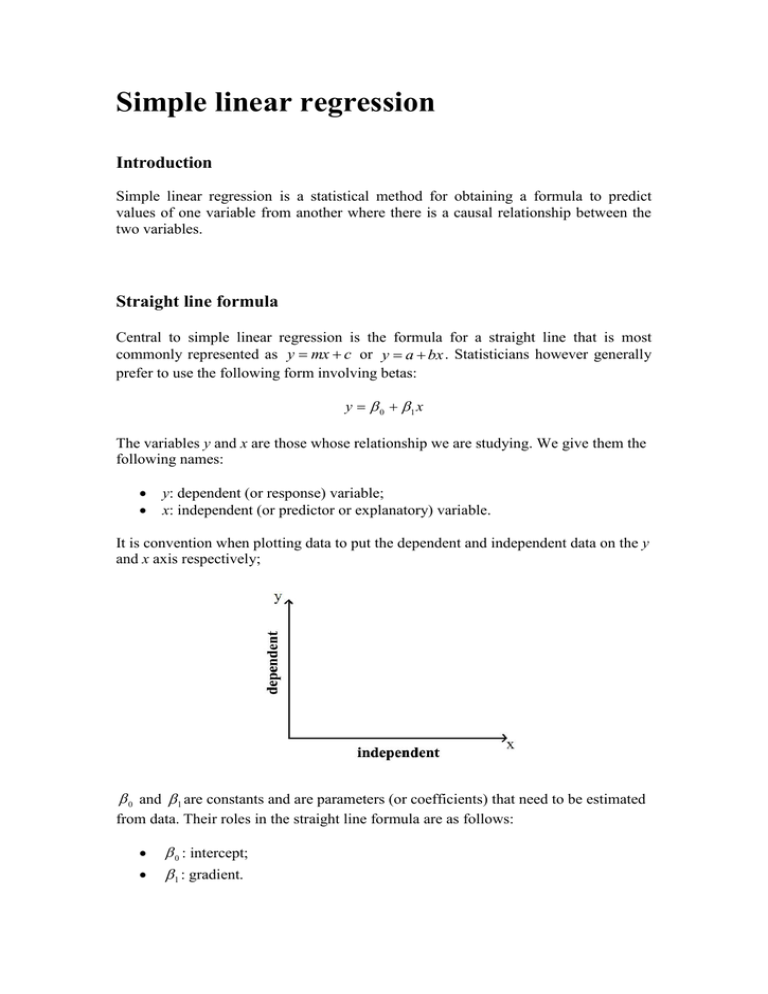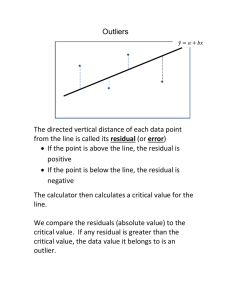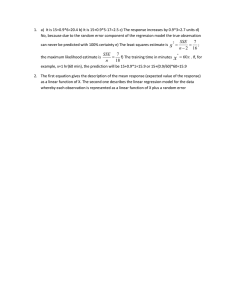Simple linear regression
advertisement

Simple linear regression Introduction Simple linear regression is a statistical method for obtaining a formula to predict values of one variable from another where there is a causal relationship between the two variables. Straight line formula Central to simple linear regression is the formula for a straight line that is most commonly represented as y mx c or y a bx . Statisticians however generally prefer to use the following form involving betas: y 0 1 x The variables y and x are those whose relationship we are studying. We give them the following names: y: dependent (or response) variable; x: independent (or predictor or explanatory) variable. It is convention when plotting data to put the dependent and independent data on the y and x axis respectively; 0 and 1 are constants and are parameters (or coefficients) that need to be estimated from data. Their roles in the straight line formula are as follows: 0 : intercept; 1 : gradient. For instance the line y 1 0.5x has an intercept of 1 and a gradient of 0.5. Its graph is as follows: Model assumptions In simple linear regression we aim to predict the response for the ith individual, Yi , using the individual‟s score of a single predictor variable, X i . The form of the model is given by: Yi 0 1 X i i which comprises a deterministic component involving the two regression coefficients ( 0 and 1 ) and a random component involving the residual (error) term ( i ). The deterministic component is in the form of a straight line which provides the predicted (mean/expected) response for a given predictor variable value. The residual terms represent the difference between the predicted value and the observed value of an individual. They are assumed to be independently and identically distributed normally with zero mean and variance 2 , and account for natural variability as well as maybe measurement error. Our data should thus appear to be a collection of points that are randomly scattered around a straight line with constant variability along the line: The deterministic component is a linear function of the unknown regression coefficients which need to be estimated so that the model „best‟ describes the data. This is achieved mathematically by minimising the sum of the squared residual terms (least squares). The fitting also produces an estimate of the error variance which is necessary for things like significance test regarding the regression coefficients and for producing confidence/prediction intervals. Example Suppose we are interested in predicting the total dissolved solids (TDS) concentrations (mg/L) in a particular river as a function of the discharge flow (m3/s). We have collected data that comprise a sample of 35 observations that were collected over the previous year. The first step is to look carefully at the data: Is there an upwards/downwards trend in the data or could a horizontal line be fit though the data? Is the trend linear or curvilinear? Is there constant variance along the regression line or does it systematically change as the predictor variable changes? 700 Total dissolved solids conc 600 500 400 300 200 0 2000 4000 6000 8000 Discharge flow The scatterplot above suggests that there is a downwards trend in the data, however there is a curvilinear relationship. The variance about a hypothetical curve appears fairly constant. Transformations Simple linear regression is appropriate for modelling linear trends where the data is uniformly spread around the line. If this is not the case then we should be using other modelling techniques and/or transforming our data to meet the requirements. When considering transformations the following is a guide: If the trend is curvilinear consider a transformation of the predictor variable, x. If constant variance is a problem (and maybe curvilinear as well) consider either a transformation of the response variable, y, or a transformation of both the response and the predictor variable, x and y. Tukey‟s “bulging rule” can act as a guide to selecting power transformations. Compare your data to the above and if it has the shape in any of the quadrants then consider the transformations where: up – use powers of the variable greater than 1 (e.g. x2, etc); down - powers of the variable less than 1 (e.g. log(x), 1/x, √x etc). Note, sometimes a second application of Tukey‟s bulging rule is necessary to gain linearity with constant variability. Example (revisited) Returning to our example, the scatterplot reveals the data to belong to the bottom left quadrant of Tukey‟s bulging rule. Since the variance about a hypothetical curve appears fairly constant, thus we shall try transforming just the predictor variable. Tukey‟s bulging rule suggests a “down” power; we shall try the log natural transformation first The resulting scatterplot of TDS against ln(Discharge) is now far more satisfactory: 700 Total dissolved solids conc 600 500 400 300 200 5.00 6.00 7.00 8.00 ln(Discharge flow) The data now appears to be suitable for simple linear regression and we shall now consider selected output from the statistics package SPSS. Correlations Total dissolved solids conc Pearson Correlation Sig. (1-tailed) N Total dissolved solids conc ln(Discharge flow) Total dissolved solids conc ln(Discharge flow) Total dissolved solids conc ln(Discharge flow) ln(Discharge flow) 1.000 -.735 -.735 1.000 . .000 .000 . 35 35 35 35 The correlations table displays Pearson correlation coefficients, significance values, and the number of cases with non-missing values. As expected we see that we have a strong negative correlation (-.735) between the two variables. From the significance test p-value we can see that we have very strong evidence (p<0.001) to suggest that there is a linear correlation between the two variables. 9.00 Model Summaryb Model 1 R .735a R Square .540 Adjusted R Square .526 Std. Error of the Estimate 78.261 a. Predictors: (Constant), ln(Discharge flow) b. Dependent Variable: Total dissolved solids conc The model summary table displays: R, the multiple correlation coefficient, is a measure of the strength of the linear relationship between the response variable and the set of explanatory variables. It is the highest possible simple correlation between the response variable and any linear combination of the explanatory variables. For simple linear regression where we have just two variables, this is the same as the absolute value of the Pearson‟s correlation coefficient we have already seen above. However, in multiple regression this allows us to measure the correlation involving the response variable and more than one explanatory variable. R squared is the proportion of variation in the response variable explained by the regression model. The values of R squared range from 0 to 1; small values indicate that the model does not fit the data well. From the above we can see that the model fits the data reasonably well; 54% of the variation in the TDS values can be explained by the fitted line together with the lnDischarge values. R squared is also known as the coefficient of determination. The R squared value can be over optimistic in its estimate of how well a model fits the population; the adjusted R square value is attempts to correct for this. Here we can see it has slightly reduced the estimated proportion. If you have a small data set it may be worth reporting the adjusted R squared value. The standard error of the estimate is the estimate of the standard deviation of the error term of the model, . This gives us an idea of the expected variability of predictions and is used in calculation of confidence intervals and significance tests. Coefficientsa Model 1 (Constant) ln(Discharge flow) Unstandardized Coefficients B Std. Error 1103.967 105.320 -101.275 16.281 Standardized Coefficients Beta -.735 t 10.482 -6.221 Sig. .000 .000 95% Confidence Interval for B Lower Bound Upper Bound 889.693 1318.242 -134.399 -68.152 a. Dependent Variable: Total dissolved solids conc The unstandardized coefficients are the coefficients of the estimated regression model. Thus the expected TDS value is given by: TDS 1103.967 101.275ln(Discharge) . Thus we can see that for each one unit increase in ln(Discharge), the TDS value is expected to decrease by 101.275 units. The intercept for this example could be interpreted as the TDS value (1103.967) when the ln(Discharge) flow is zero (i.e. Discharge = 1 m3/s. The standardized coefficients are appropriate in multiple regression when we have explanatory variables that are measured on different units. These coefficients are obtained from regression after the explanatory variables are all standardized. The idea is that the coefficients of explanatory variables can be more easily compared with each other as they are then on the same scale. In simple linear regression they are of little concern. The standard errors give us estimates of the variability of the (unstandardised) coefficients and are used for significance tests for the coefficients and for the displayed 95% confidence intervals. The t values and corresponding significance vales are tests assessing the worth of the (unstandardised) coefficients. It is usually of importance to be assessing the worth of our predictor variable and hence evaluating the significance of the coefficient 1 in our model formulation. That is we are assessing for evidence of a significant non-zero slope. If the coefficient is not significantly different to zero then this implies the predictor variable does not influence our response variable. Here we have both test are highly significant (p<0.001), indicating that we have very strong evidence of need both the coefficients in our model. The resulting confidence intervals expand our understanding of the problem. For example, with 95% confidence we believe that the interval between -134.399 and -68.152 covers the true unknown TDS value change per ln(Discharge) unit. The remaining output is concerned with checking the model assumptions of normality, linearity, homoscedasticity and independence of the residuals. Residuals are the differences between the observed and predicted responses. The residual scatterplots allow you to check: Normality: the residuals should be normally distributed about the predicted responses; Linearity: the residuals should have a straight line relationship with the predicted responses; Homoscedasticity: the variance of the residuals about predicted responses should be the same for all predicted responses. Residuals Statisticsa Predicted Value Residual Std. Predicted Value Std. Residual Minimum 198.53 -128.404 -3.060 -1.641 Maximum 558.19 214.702 1.248 2.743 Mean 454.00 .000 .000 .000 a. Dependent Variable: Total dissolved solids conc Std. Deviation 83.491 77.101 1.000 .985 N 35 35 35 35 The above table summarises the predicted values and residuals in unstandarised and standardised forms. It is usual practice to consider standardised residuals due to their ease of interpretation. For instance outliers (observations that do not appear to fit the model that well) can be identified as those observations with standardised residual values above 3.3 (or less than -3.3). From the above we can see that we do not appear to have any outliers. Histogram Dependent Variable: Total dissolved solids conc 10 Frequency 8 6 4 2 Mean = 3.52E-16 Std. Dev. = 0.985 N = 35 0 -2 -1 0 1 2 3 Regression Standardized Residual The above plot is a check on normality; the histogram should appear normal; a fitted normal distribution aids us in our consideration. Serious departures would suggest that normality assumption is not met. Here we have a slight suggestion of positive skewness but considering we have only 35 data points we have no real cause for concern. Normal P-P Plot of Regression Standardized Residual Dependent Variable: Total dissolved solids conc 1.0 Expected Cum Prob 0.8 0.6 0.4 0.2 0.0 0.0 0.2 0.4 0.6 0.8 1.0 Observed Cum Prob The above plot is a check on normality; the plotted points should follow the straight line. Serious departures would suggest that normality assumption is not met. Here we have no major cause for concern. Scatterplot Dependent Variable: Total dissolved solids conc Regression Standardized Residual 3 2 1 0 -1 -2 -4 -3 -2 -1 0 1 2 Regression Standardized Predicted Value The above scatterplot of standardised residuals against predicted values should be a random pattern centred around the line of zero standard residual value. The points should have the same dispersion about this line over the predicted value range. From the above we can see no clear relationship between the residuals and the predicted values which is consistent with the assumption of linearity. The dispersion of residuals over the predicted value range between -1 and 1 looks constant, for predicted values below -1 there is too few points to provide evidence against a change in variability. Model violations So what do residual scatterplots of models that violate the model look like? Here are two common examples together with suggested remedies for the next regression to try. Scatterplot Regression Standardized Residual Dependent Variable: y 4 2 0 -2 -1 0 1 2 3 4 5 Regression Standardized Predicted Value 6 In the plot above there is clear evidence of heteroscedasticty; change of variance with predicted value. Try log natural or square root transformation of y to stabilise variance. Scatterplot Regression Standardized Residual Dependent Variable: y 2 1 0 -1 -2 -1 0 1 2 Regression Standardized Predicted Value In the plot above there is a clear curved pattern in the residuals. Try transforming x to obtain a linear relationship between it and the response variable. Example (revisited) In order to get TDS predictions for particular Discharge values we can use the fitted line, say for a Discharge of 2000 m3/s: TDS 1103.967 101.275ln(2000) 334.186 Alternatively, we could let a statistics like SPSS to do the work and calculate confidence or prediction intervals at the same time. We shall now consider some of the other output that SPSS gives us. The following gives the fitted line together with 95% confidence interval for the expected TDS response. 700 Total dissolved solids conc 600 500 400 300 R Sq Linear = 0.54 200 5.00 6.00 7.00 ln(Discharge flow) 8.00 9.00 When requesting a predicted value we can also obtain the following: the predicted values for the various Discharges together with the associated standard errors of the predictions; 95% CI for the expected response; 95% CI for individual predicted responses; For example for a Discharge of 2000 m3/s: the expected TDS is 334.18 mg/L (s.e. = 23.366); we are 95% certain that interval from 286.64 to 381.72 mg/L covers the unknown expected TDS value; we are 95% certain that interval from 168.01 to 500.35 mg/L covers the range of predicted individual TDS observations. Caution: beware of extrapolation! It would be unwise to predict the TDS for a Discharge value of 12,000 m3/s as this is far beyond the observed data range.




